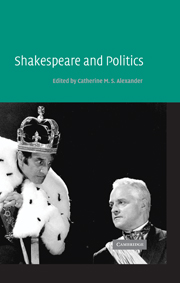Book contents
- Frontmatter
- Contents
- List of contributors
- Editor's note
- 1 Shakespeare and politics: an introduction
- 2 Shakespeare and politics
- 3 Henry VIII and the deconstruction of history
- 4 Livy, Machiavelli, and Shakespeare's Coriolanus
- 5 Richard II and the realities of power
- 6 Plutarch, insurrection, and dearth in Coriolanus
- 7 Some versions of coup d'état, rebellion, and revolution
- 8 Language, politics, and poverty in Shakespearian drama
- 9 ‘Demystifying the mystery of state’: King Lear and the world upside down
- 10 Venetian culture and the politics of Othello
- 11 The Bard and Ireland: Shakespeare's Protestantism as politics in disguise
- 12 Henry V as working-house of ideology
- 13 ‘Fashion it thus’: Julius Caesar and the politics of theatrical representation
- 14 Take me to your Leda
- 15 Macbeth on film: politics
- 16 William Shakespeare's Romeo + Juliet: everything's nice in America?
- Index
5 - Richard II and the realities of power
Published online by Cambridge University Press: 05 June 2012
- Frontmatter
- Contents
- List of contributors
- Editor's note
- 1 Shakespeare and politics: an introduction
- 2 Shakespeare and politics
- 3 Henry VIII and the deconstruction of history
- 4 Livy, Machiavelli, and Shakespeare's Coriolanus
- 5 Richard II and the realities of power
- 6 Plutarch, insurrection, and dearth in Coriolanus
- 7 Some versions of coup d'état, rebellion, and revolution
- 8 Language, politics, and poverty in Shakespearian drama
- 9 ‘Demystifying the mystery of state’: King Lear and the world upside down
- 10 Venetian culture and the politics of Othello
- 11 The Bard and Ireland: Shakespeare's Protestantism as politics in disguise
- 12 Henry V as working-house of ideology
- 13 ‘Fashion it thus’: Julius Caesar and the politics of theatrical representation
- 14 Take me to your Leda
- 15 Macbeth on film: politics
- 16 William Shakespeare's Romeo + Juliet: everything's nice in America?
- Index
Summary
There is a scene in an Elizabethan play on the reign of Richard II – the play, anonymous and without title, of uncertain date and theatrical provenance, now commonly called Woodstock or Thomas of Woodstock – in which one of the caterpillars of the commonwealth enters the royal presence poring over a book. ‘How now, what readst thou, Bushy?’, asks the King. To which his favourite replies:
The monument of English Chronicles,
Containing acts and memorable deeds
Of all your famous predecessor kings.
This book – is it Holinshed (a bit large for the purpose) or Stow evoked in a kind of surreal flash-forward? – holds examples, strange and wonderful, of treason and conquest applicable to Richard's own predicament. The information on which he eagerly seizes, however, is more prosaic. Bushy reads: ‘Upon the 3rd of April 1365 was Lord Richard, son to the Black Prince, born at Bordeaux.’ ‘1365 …’, muses the King. ‘What year is this?’ (This is one of those plays in which characters ask the year, presumably more for the spectators' benefit than their own; it is not dramaturgy of a Shakespearian order.) The year, it turns out, is 1387. Thus does it dawn on Richard that he has reached his majority. He can now claim his birthright, the throne of England, and set in motion the catastrophic sequence of events which will lead to his fall.
- Type
- Chapter
- Information
- Shakespeare and Politics , pp. 91 - 109Publisher: Cambridge University PressPrint publication year: 2004
- 1
- Cited by



